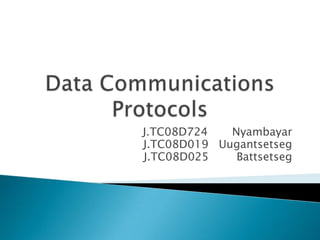
2010fall ch6 uugantsetseg
- 1. Data CommunicationsProtocols J.TC08D724 Nyambayar J.TC08D019 Uugantsetseg J.TC08D025 Battsetseg
- 2. The Open Systems Interconnect model Protocols Ethernet: IEEE 802.3 Transmission Control Protocol/Internet Protocol (TCP/IP) Transmission Control Protocol (TCP) User Datagram Protocol (UDP) Internet Protocol (IP) IP addresses Methods
- 3. The data industry borrowed the protocol term, an apt metaphor, from the world of diplomacy. In the realm of international affairs, diplomats are concerned with such details as the syntax for expressions, the order of precedence, the form of greeting, and other conventions that puzzle most of us. The same is true in communications networks. Data CommunicationsProtocols
- 4. THE OPEN SYSTEMS INTERCONNECT MODEL
- 6. Layer1-Physical Layer 1 transfers bits across a circuit, which can be any transmission medium including wire, fiber optics, coaxial cable, or wireless. Layer2-Datalink Datalink protocols provide link integrity to transmit frames of data between endpoints.
- 7. Layer 3—Network The network layer routes packets between endpoints on a network. A packet is a frame with a header that contains addressing and other information. Layer 4—Transport The transport layer assures integrity between endpoints. Transport protocols establish and terminate connections, segment data into manageable PDUs, and reassemble them at the receiving end.
- 8. Layer 5—Session Session service is an optional function that may be embedded in the application as opposed to employing a separate protocol. Layer 6—Presentation This layer provides the syntax for the session. For example, it might translate between ASCII and EBDIC if the two systems use a different format. Layer 7—Application Examples of application layer functions now in use are ITU-T’s X.400 Electronic Mail Protocol and its companion X.500 Directory Services Protocol.
- 9. Standards work began with modest objectives of sharing facilities: files, expensive peripherals such as printers and plotters, and software applications. It was not easy to foresee additional requirements that have since materialized, including access to mainframe computers and connectivity to WANs. ETHERNET: IEEE 802.3
- 10. Stations can detect other transmissions in a wired network, but a finite time known as the collision window is required for a pulse to traverse the length of the medium. As Figure shows, a node at one end of a LAN may begin to transmit without detecting that a node at the other end of the network has also begun to transmit, so the frames collide.
- 11. TRANSMISSION CONTROL PROTOCOL/INTERNETPROTOCOL (TCP/IP) In the 1970s, the Department of Defense commissioned the development of the TCP/IP suite of protocols to provide interoperability among computers. In late 1989, the original ARPANET evolved into a network that subsequently became the Internet.
- 12. The original Internet had four primary purposes: To provide electronic mail service to the users To support file transfer between hosts To permit users to log on remote computers To provide users with access to information databases
- 14. Transmission Control Protocol (TCP) TCP is a connection-oriented guaranteed-delivery protocol that interoperates with IP to deliver packets across a network. TCP/IP is independent of the physical medium. The protocol makes use of the physical and datalink layers on the LAN. Between the LANs, the WAN protocols handle packet transfer.
- 15. User Datagram Protocol (UDP) Error correction delays packet flow. To a data application, delay is either invisible or appears as a longer response time, which may be annoying but does not affect integrity. Internet Protocol (IP) Routers at IP nodes usually have multiple paths for delivering packets. An IP datagram contains a header that is 20 octets or more in length plus a data field that can be up to 65,535 octets long.
- 16. The application sends a data stream to TCP, which chops it into packets, appends a TCP header, and sends it to IP for routing.
- 17. IP Addresses Every device connected to a TCP/IP network requires at least one unique IP address. The address consists of four octets expressed in decimal format and separated by dots, which makes it easier to read than in binary form.
- 18. Thanks for your attention…
